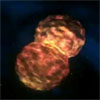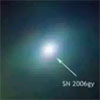CXC Home | Search | Help | Image Use Policy | Latest Images | Privacy | Accessibility | Glossary | Q&A
Animation of SN 2006gy
Quicktime MPEG
This animation shows an artist's rendition of how SN 2006gy exploded. The extremely massive star shed some of its outer layers in a large eruption prior to its violent collapse. The explosion then plows into the expelled cooler gas, creating a brilliant light show. Astronomers think Eta Carinae in the Milky Way could explode in the same way at any time.
[Runtime: 0:22]
(Credit: NASA/CXC/G.Bacon)
Quicktime MPEG
This animation shows an artist's rendition of how SN 2006gy exploded. The extremely massive star shed some of its outer layers in a large eruption prior to its violent collapse. The explosion then plows into the expelled cooler gas, creating a brilliant light show. Astronomers think Eta Carinae in the Milky Way could explode in the same way at any time.
[Runtime: 0:22]
(Credit: NASA/CXC/G.Bacon)
SN 2006gy Image Sequence
Quicktime MPEG
This sequence of images begins with an infrared image from the PAIRITEL telescope centered on NGC 1260. We then zoom into the middle of this galaxy and show an infrared adaptive optics image from Lick Observatory. The nucleus of the galaxy and the supernova SN 2006gy are labelled. The Chandra image is then shown, again showing the nucleus of NGC 1260 and SN 2006gy. The Chandra observation allowed the team to rule out the most likely alternative explanation for the explosion. If the supernova was caused by a white dwarf star exploding into a dense, hydrogen-rich environment, rather than the collapse of a massive star, SN 2006gy should have been about 1,000 times brighter in X-rays than what Chandra detected.
[Runtime: 0:26]
(Credit: X-ray: NASA/CXC/UC Berkeley/N.Smith et al.; IR: Lick/UC Berkeley/J.Bloom & C.Hansen)
Quicktime MPEG
This sequence of images begins with an infrared image from the PAIRITEL telescope centered on NGC 1260. We then zoom into the middle of this galaxy and show an infrared adaptive optics image from Lick Observatory. The nucleus of the galaxy and the supernova SN 2006gy are labelled. The Chandra image is then shown, again showing the nucleus of NGC 1260 and SN 2006gy. The Chandra observation allowed the team to rule out the most likely alternative explanation for the explosion. If the supernova was caused by a white dwarf star exploding into a dense, hydrogen-rich environment, rather than the collapse of a massive star, SN 2006gy should have been about 1,000 times brighter in X-rays than what Chandra detected.
[Runtime: 0:26]
(Credit: X-ray: NASA/CXC/UC Berkeley/N.Smith et al.; IR: Lick/UC Berkeley/J.Bloom & C.Hansen)
Return to SN 2006gy (07 May 07)




